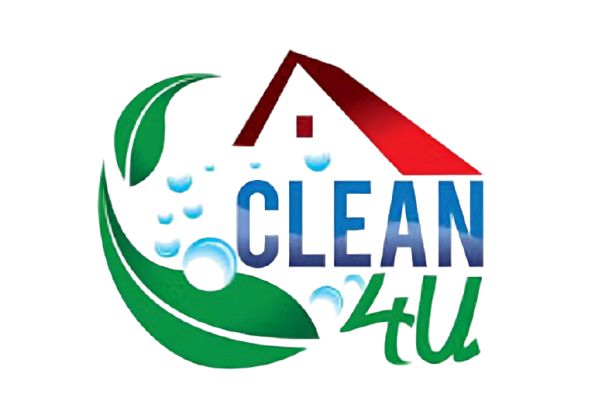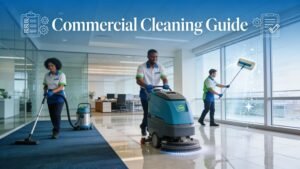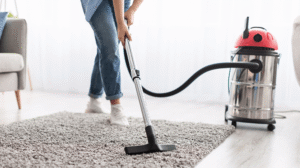It’s imperative to understand the key factors influencing the overall cost of cleaning your commercial office. These elements include the size of your space, the frequency of cleaning, the type of services required, and the level of customization you desire. Each aspect contributes significantly to your cleaning budget, affecting not just costs but also the quality of service and employee productivity. By grasping these underlying components, you can make informed decisions that align with your financial and operational goals.
Key Takeaways:
- The size and layout of the office space significantly influence cleaning costs, with larger and more complex spaces requiring more time and resources.
- The frequency of cleaning services impacts overall expenses, with regular schedules often resulting in lower per-visit costs compared to infrequent cleanings.
- The choice of cleaning products and equipment, including eco-friendly options, can affect pricing due to varying material costs and labor requirements.
Understanding the Commercial Cleaning Market
Industry Overview
The commercial cleaning market is a robust and diverse sector that encompasses a wide array of services tailored for various business environments. According to the Global Commercial Cleaning Services Market Report, the market is projected to reach approximately $74 billion by 2025, driven by the increasing demand for cleanliness and hygiene in workplaces. With heightened awareness around health and safety, especially in light of recent global events, businesses are prioritizing regular and thorough cleaning routines, impacting overall costs. Moreover, the rise in office space renovations and expansions further contributes to the complexity and variance in service demands.
As you examine into this market, it’s imperative to recognize the diverse needs of different industries, ranging from corporate offices to healthcare facilities. Each sector has unique cleaning requirements, materials, and standards that must be met, influencing the pricing structure. For instance, a healthcare facility must adhere to strict sanitation protocols, potentially increasing your costs compared to a standard office environment, where less stringent cleaning may be sufficient.
Key Players and Service Models
The commercial cleaning landscape is populated by numerous key players, including multinational corporations and localized service providers. Major companies such as ABM Industries and ISS World provide integrated facility services that combine cleaning with maintenance and security, positioning them as comprehensive service solutions for larger entities. Furthermore, many businesses opt for either in-house cleaning staff or outsourcing these services, which dramatically alters your cost dynamics based on labor expenses and the required level of specialization.
Your decision to choose between a national service provider or a local cleaning company can significantly impact not only pricing but also service quality. National companies often offer standardization and scalability, promising uniform cleaning standards across multiple sites, while local firms may provide more personalized services and flexible contracts, catering specifically to your unique office environment.
In addition, service models range from contract-based agreements—often secure lower long-term rates—to project-based setups for one-time deep cleans or specialized tasks. This variety allows you to tailor cleaning services to your specific needs and budget. Understanding the service models available empowers you to make informed choices that align with operational goals and financial considerations.
Factors Influencing Cleaning Costs
Your cleaning costs can fluctuate significantly based on various elements unique to your office environment. Understanding these factors can help you make informed decisions when budgeting for cleaning services. Key aspects that play a role include size and type of office space, as well as the frequency of cleaning services, among others.
- Size of the office space
- Type of business or industry
- Frequency of cleaning services
- Level of cleaning required
- Additional services requested
Size and Type of Office Space
The size of your office space directly correlates to the cleaning costs. Larger offices require more time and materials to clean, thus resulting in higher expenses. A 1,000 square foot office may need less than half of the budget of a 5,000 square foot one. Additionally, the type of office space, whether it’s an open-plan layout or a mix of private offices and conference rooms, affects cleaning efficiency and time, further influencing the overall cost.
Complexity also plays a role; for instance, cleaning an office filled with specialized equipment or requiring specific cleaning methods can demand more specialized services, increasing the expense. In contrast, a straightforward retail space may have more predictable and lower cleaning costs due to standard procedures.
Frequency of Cleaning Services
The frequency of cleaning services largely dictates your overall cleaning budget. Regular cleaning, whether daily, weekly, or monthly, tends to lower costs compared to sporadic or one-time deep cleans. Weekly services might be more economical per visit than a series of one-off cleans, as providers can schedule their work more efficiently around your needs.
Engaging in a consistent cleaning schedule allows cleaning personnel to maintain your space effectively, reducing the time spent on each visit due to less buildup of dirt and grime. Any additional one-time services, such as deep cleaning, carpet shampooing, or window washing, will typically incur extra charges, making it vital to evaluate your regular maintenance alongside these special requests. You may find that creating a regular cleaning plan not only meets your aesthetic needs but also saves you costs in the long run.
Labor Costs in Commercial Cleaning
Wage Expectations
When evaluating labor costs in commercial cleaning, you must consider wage expectations. In the United States, the average hourly wage for cleaning personnel ranges from $12 to $25, depending on factors such as location, experience, and the complexity of tasks involved. If your office is in a major metropolitan area, you might find that your cleaning service providers charge more due to the higher cost of living and wage standards. Furthermore, unionized labor may drive costs further up, adding another layer of expense to your cleaning budget.
Additionally, overtime pay for workers who exceed standard hours can significantly impact your overall costs. Knowing the wage structures can help you negotiate better contracts and ensure that you’re budgeting appropriately for ongoing cleaning services, potentially saving you from unexpected financial strain in the long run.
Training and Retention
Effective training programs play a vital role in maintaining high standards of cleanliness while also influencing labor costs. You should ensure that your cleaning staff is well-trained on safety protocols and efficient cleaning techniques. Training sessions can cost between $500 to $1,000 per employee, depending on the depth of the program, but they often pay off in terms of improved performance and lower turnover rates.
Retention of qualified staff is equally imperative, as high turnover increases recruitment and training expenses. Offering competitive wages, benefits, and opportunities for advancement can aid in retaining skilled workers. Studies indicate that companies with effective retention strategies can save up to 20% of annual labor costs through decreased turnover.
Investing in both training and employee retention creates a more reliable workforce. A solid training program ensures that your employees are equipped with the necessary skills to handle various cleaning tasks efficiently, while a focus on retention fosters a stable environment where experienced workers can excel. This not only enhances the quality of cleaning services provided but also limits the financial impacts associated with high turnover and ongoing recruitment efforts.
Supplies and Equipment Overheads
Quality of Cleaning Products
The quality of cleaning products you choose can significantly impact both performance and expense. Opting for eco-friendly, high-quality solutions not only promotes a healthier workspace but also often leads to lower long-term costs as they are more effective and may reduce the need for frequent applications. For instance, using a concentrated cleaner instead of traditional diluted products can minimize shipping costs and storage requirements, saving you both money and space in your office.
It’s imperative to evaluate suppliers based on their product efficacy and safety certifications. Products that carry certifications such as Green Seal or EPA Safer Choice often justify a higher price with their superior cleaning properties and reduced toxicity. Investing in better products can lead to higher employee satisfaction and improved productivity as well, emphasizing that you’re not just spending but investing in your workplace environment.
Technological Advancements
Investing in advanced cleaning technologies can seem like a higher upfront cost, but these innovations typically lead to lower overall operational costs. For example, automated floor scrubbers or robotic vacuums not only enhance efficiency but also free up your staff to focus on more complex cleaning tasks, thereby maximizing their productivity. In many cases, commercial-grade equipment with smart technology can produce cleaner results while using less water and cleaning agents, resulting in significant savings over time.
Advanced cleaning technologies, including UV-C light sanitation and electrostatic sprayers, are gaining traction due to their proven effectiveness against pathogens, making your workspace safer. By integrating these solutions, you not only reduce manual labor but also enhance the sanitation standards within your office, catering to the health concerns of your employees and clients alike.
For instance, companies that utilize robotic cleaners have reported a 30% reduction in labor costs while enhancing the efficiency of their cleaning processes. This demonstrates how embracing technology can lead to significant savings and improved cleaning outcomes, ultimately raising your cleaning service return on investment.
Environmental Considerations
Green Cleaning Practices
Incorporating green cleaning practices into your cleaning regimen can influence overall costs positively. Using environmentally friendly products often reduces the need for chemical-heavy options, resulting in fewer health hazards for your employees and clients. It’s estimated that green cleaning can lower absenteeism by up to 20% due to improved indoor air quality, thereby enhancing employee productivity. Investing in sustainable practices often yields long-term savings as well; for instance, energy-efficient cleaning equipment can reduce utility costs while maintaining high standards of cleanliness.
Moreover, clients increasingly value sustainability, meaning eco-friendly practices can enhance your company’s reputation. Selecting certified green products may involve a higher upfront cost, but companies can often negotiate bulk purchase agreements or take advantage of local incentives for sustainable businesses, ultimately balancing initial expenses with potential savings over time.
Regulatory Compliance
Adhering to local, state, and federal regulations regarding cleaning materials and methods directly affects your cleaning costs. For example, the Environmental Protection Agency (EPA) mandates specific standards for cleaning agents in commercial use, which can dictate your choices and operational practices. Non-compliance can lead to fines, and even lawsuits, which can considerably inflate the overall cost of your cleaning operations. Additionally, staying compliant may require investing in staff training programs to ensure your team understands the regulations and uses cleaning products safely.
Furthermore, by regularly auditing your cleaning protocols alongside regulatory updates, you can proactively address compliance issues. This vigilance not only mitigates potential legal risks but also fosters a culture of safety and environmental responsibility within your organization. The potential financial implications of non-compliance may discourage some investments, but the benefits of aligning with best practices in the industry often outweigh these risks.
Customizing Cleaning Contracts
Tailored Service Packages
Creating a cleaning contract that fits your specific needs often involves tailored service packages. These packages allow you to pick and choose the cleaning services that best suit your office environment, whether it’s daily dusting, weekly carpet cleaning, or monthly deep cleans. By customizing your package, you not only enhance the workspace’s cleanliness but also manage costs more effectively, targeting the areas that require the most attention while potentially reducing expenditures on less critical services.
For instance, consider an office that experiences heavy foot traffic; incorporating more frequent floor maintenance into your contract can ensure a cleaner, safer environment. Conversely, if your office sees fewer visitors, you might opt for a less intensive schedule, allowing for a more cost-effective approach without sacrificing quality.
Long-term vs. Short-term Contracts
Your decision between long-term and short-term cleaning contracts significantly impacts both pricing and service quality. Long-term contracts generally offer substantial discounts because cleaning companies benefit from guaranteed business. For example, a company might charge a lower rate for a one-year commitment compared to a month-to-month arrangement, which often bears a premium since it provides less stability for the service provider.
On the other hand, short-term contracts offer flexibility, which can be advantageous for businesses with fluctuating needs or budget constraints. You might choose a short-term contract to test a service’s effectiveness without committing long-term. However, the trade-off can often be higher costs and less priority in scheduling, especially during peak service times.
Weighing your options is crucial; a long-term contract often results in better service continuity and can foster a stronger working relationship with your chosen cleaning provider. Conversely, a short-term arrangement might be ideal for seasonal businesses or those in transition. Evaluating your office’s stability and cleaning needs against budgetary considerations will guide you in making the most beneficial choice.
Summing up
Drawing together the various components that influence the overall cost of cleaning a commercial office, you should consider factors such as the size of the space, frequency of cleaning, and the specific services required. Larger offices will naturally incur higher costs due to increased labor and materials, while the choice of routine versus specialized cleaning tasks will impact your budget significantly. Additionally, the condition of your office before cleaning can dictate the intensity of the services needed, ultimately affecting your expenditure.
Furthermore, the geographic location of your office can play a role in pricing, as labor rates and overhead costs can vary by region. Your choice of cleaning provider and the type of cleaning products used can also influence overall expenses. By assessing these elements and tailoring your cleaning strategy to fit your specific needs, you can make informed decisions that align with your budget while maintaining a clean and healthy work environment.
FAQ
Q: What factors influence the cost of cleaning a commercial office?
A: The main factors that influence the cost of cleaning a commercial office include the size of the office space, the frequency of cleaning services, the level of cleaning required (standard vs. deep cleaning), and the types of surfaces and materials that need specialized care. Additional considerations may include the location of the office and any specific client requirements.
Q: How does the type of cleaning products and equipment affect cleaning costs?
A: The type and quality of cleaning products and equipment used can significantly affect overall cleaning costs. Eco-friendly or specialized cleaning solutions may be more expensive, and commercial-grade equipment often requires higher maintenance. The choice of products and equipment will depend on the cleaning service’s standards and the specific needs of the office.
Q: What role do labor costs play in the overall cleaning expense for a commercial office?
A: Labor costs are a major component of cleaning expenses. The number of staff required for the job, their level of experience, and the time taken to complete the cleaning all contribute to labor costs. Additionally, higher labor costs may apply if after-hours cleaning is requested or if specialized cleaning services are needed, such as for sensitive environments.







